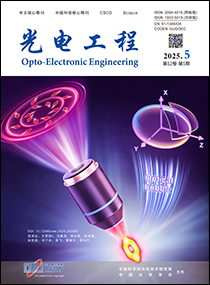Current Issue
2025 Vol. 52, No. 5
Cover story: Zheng Z C, Wang S C, Feng J H, et al. Generation and detection of a tightly focused uniform optical bubble based on single-beam vector field modulation[J]. Opto-Electron Eng, 2025, 52(5): 250052
Optical bubble, characterized by a tightly focused three-dimensional dark-field intensity distribution, exhibits significant application value in fields such as optical manipulation and laser processing. In previously reported results, an optical bubble is typically generated through multi-beam interference and superposition, which involves complex optical setups and is not conducive to system integration and practical applications, and has low energy utilization efficiency. In this study, we utilize single-beam vector field modulation technology to generate a tightly focused optical bubble with high intensity uniformity. Furthermore, we achieve the detection of this hollow bubble through polarization conversion of the probe light. By adjusting the energy ratio between azimuthally polarized incident beam and radially polarized incident beam modulated by a 0/π binary phase, we experimentally realize an optical bubble with an edge-to-center dark spot intensity ratio exceeding 10:1 and edge intensity uniformity approaching 90%. This work provides a feasible technical approach for applications in dual-beam super-resolution laser processing, optical data storage, and particle manipulation.

-
{{article.year}}, {{article.volume}}({{article.issue}}): {{article.fpage | processPage:article.lpage:6}}. doi: {{article.doi}}{{article.articleStateNameEn}}, Published online {{article.preferredDate | date:'dd MMMM yyyy'}}, doi: {{article.doi}}{{article.articleStateNameEn}}, Accepted Date {{article.acceptedDate | date:'dd MMMM yyyy'}}CSTR: {{article.cstr}}
-
{{article.year}}, {{article.volume}}({{article.issue}}): {{article.fpage | processPage:article.lpage:6}}. doi: {{article.doi}}{{article.articleStateNameEn}}, Published online {{article.preferredDate | date:'dd MMMM yyyy'}}, doi: {{article.doi}}{{article.articleStateNameEn}}, Accepted Date {{article.acceptedDate | date:'dd MMMM yyyy'}}CSTR: {{article.cstr}}

 E-mail Alert
E-mail Alert RSS
RSS


